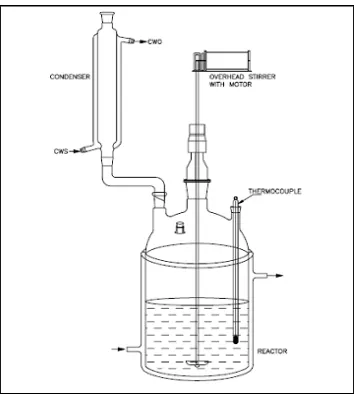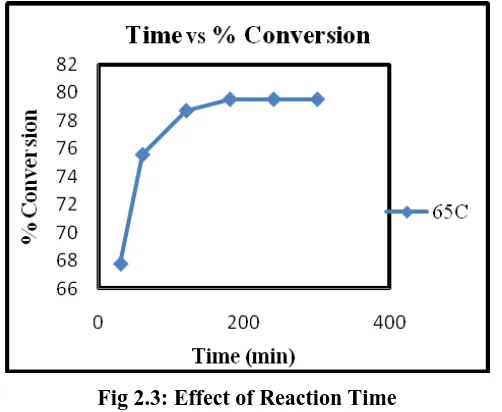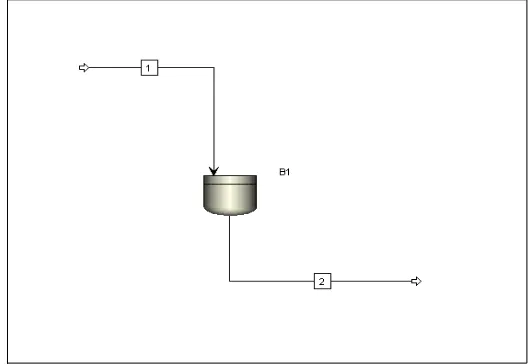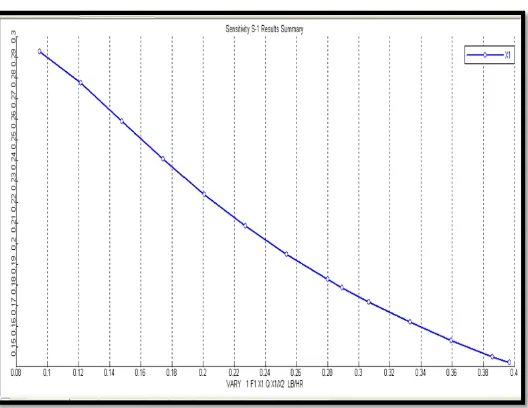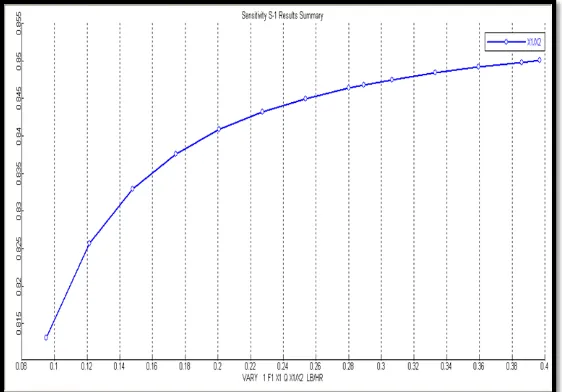ESTERIFICATION REACTION OF ACETIC ACID
AND ETHANOL WITH H
2
SO
4
: BATCH KINETICS
AND SIMULATION APPROACH
Manisha S. Manjare
1, Onkar A. Deorukhkar
2, Vivek S. Sathe
31,2,3
Department of Chemical Engineering, Dr. B. A. T. U. Lonere, Raigad, (India)
ABSTRACT
Esterification represents one of the most important reactions in chemical industry and the esters produced have
applications in a variety of areas such as plasticizers, flavours and fragrances, pesticides, solvents, medicinal
and surface active agents. The Esterification kinetics of acetic acid with ethanol in the presence of sulphuric
acid as a homogenous catalyst was studied with batch experiments at four different temperatures and at a
different molar ratio of ethanol to acetic acid with 5% catalyst loading. Investigation of kinetics of the reaction
indicated that the increasing the [Ac/EtOH] molar ratio is favoured for esterification reaction, this is due to the
reaction is catalyzed by acid. The maximum conversion, approximately 83% was obtained at 65°C for molar
ratio of Ac/5EtOH. With the help of Aspen Plus we can design plants and can attempt profitability in existing
plants. We can interactively change specifications, such as flow sheet Configuration, operating conditions, and
feed compositions, to run new cases and analyze alternative. Sensitivity analysis predicts how much sensitive
process or a model, to a particular variable. Using sensitivity analysis it is observed that the mole ratio is
highly sensitive parameter while as temperature up to certain range is sensitive.
Keywords:
Acetic Acid, Aspen Plus, Batch Kinetics, Esterification, Ethanol, Sensitivity.
I. INTRODUCTION
Esterification is a well-known process and a number of industrially important chemicals such as methyl, ethyl
and butyl esters, alkyl t-butyl ethers (MTBE and ETBE) are produced using esterification reactions. Esters are
important classes of chemicals have many applications in a variety of areas such as solvents, plasticizers,
pharmaceuticals and intermediate for many industries (Kirk and Othmer 1980, Yadav and Metha, 1994).
Sensitivity Analysis in ASPEN PLUS determines how a process reacts to varying key operating and design
variables. We can use it to vary one or more flow sheet variables and study the effect of that variation on other
flow sheet variables. It conveniently generates tables and plots showing how process performance varies with
changes to selected equipment specifications and operating conditions.It has feature torun multiple simulations
with different input for comparison and analysis. Design Specification capabilities to automatically calculate
operating conditions or equipment parameters to meet specified performance targets. Sensitivity analysis is
important to verify if the solution to a design specification lies within the range of the manipulated variable.
It explored the Plant Operating Conditions that will maximize any objective function specified, including
II. EXPERIMENTATION
2.1 Kinetics of Esterification of Ethyl Alcohol by Acetic Acid
The Esterification kinetics of acetic acid with ethanol in the presence of sulphuric acid as a homogeneous
catalyst was studied with isothermal batch experiments at 45-750C and at a different molar ratio of acetic acid to
ethanol. The overall reaction between acetic acid and ethyl alcohol over a sulphuric acid catalyst is as follows:
CH3COOH + C2H5OH CH3COOC2H5 + H2O
Acetic acid + ethanol ethyl acetate + water
(A) (B) (C) (D)
This reaction is reversible, exothermic and the equilibrium composition is a weak function of temperature. The
reaction is acid catalysed, and as for most esterification usually strong mineral acids (hydrochloric acid,
sulphuric acid) are used.
Fig 2.1: Schematic Representation of Batch Kinetics Setup
2.1.1 Materials and Catalyst
All the reagents were of synthesis grade and obtained from Merck AG. Acetic acid and ethyl alcohol,
respectively was 99.98 % w/w and 96 % w/w and rest being water. The experimental assembly consisted of
a 250 ml reactor fitted with a long reflux condenser to prevent any loss of products and a thermometer
pocket. Aliquots of sample were taken via reflux condenser. A steel stirrer was used to stir the reaction mixture.
The reaction vessel was placed in a thermostat bath with an electronic temperature regulator (+/- 0.10 K).
Experiments were conducted at various molar ratios of acetic acid and ethyl alcohol in the temperature range of
318.15K, 328.15K, 338.15K, 348.15K, and 358.15 K using 5% catalyst concentrations. The sulphuric acid
catalyst is used for the production of ethyl acetate. The amount of catalyst used is 5% of limiting reactant i.e.
acetic acid.
2.1.2 Effect of Temperature
In order to study the effect of temperature on the reaction, experiments were carried out over a range of
temperatures (318-358 K). Figure shows the plot of conversion vs. time at different temperatures. As expected,
the rate of reaction and hence conversion increases as temperature is increased from 318.15 to 358.15 K. since
Fig 2.2: Effect of Temperature on % conversion
2.1.3 Effect of Reaction Time
To study the effect of time on the reaction, experiment was carried out for 5 hour at 650C temperature. Figure
shows the plot of conversion vs. time at 650C temperature. As expected, the rate of reaction and hence
conversion increases as time is increased.
Fig 2.3: Effect of Reaction Time
Since this is a reaction with no observable side reaction; it is clear that as the time increases conversion also
increases.
2.1.4 Effect of Mole Ratio
In order to study the effect of mole ratio on the reaction, experiments were carried out over a range of mole ratio
1:1, 1:2, 1:3 and 1:5. Figure shows the plot of conversion vs. mole ratio. As expected, the rate of reaction and
hence conversion increases as the mole ratio is increased from 1:1 to 1:5. Since this is a reaction with no
Fig 2.4: Effect of Mole Ratio
III. SENSITIVITY ANALYSIS
Here,Sensitivity analysis will be introduced with esterification reaction in batch reactor. In this task the effect of
change in manipulated variable like temperature and mole flow of ethanol in RBATCH block B1 on the product
concentration is to be done, also the effect of mole flow rate of acetic acid on the concentration of product in the
reactor outlet. For doing the sensitivity analysis of esterification reaction, basic simulation of that reaction must
be encountered.
3.1 Manipulated Variable: Reaction Temperature: Reaction temperature Pressure (atm) Acetic Acid (gm) Ethanol (gm) Water (gm) Mass of solution (gm) Reaction Time (hr)
450C -850C 1 43 131 2.15 176.15 5
3.2 Manipulated Variable: Mass flow rate of Ethanol
Ethanol
(Kg/ hr)
Reaction
temperature (0C)
Pressure (atm) Water (gm) Reaction Time (hr)
0.043 – 0.180 650C 1 2.15 5 hr
Fig 3.2: Sensitivity Analysis (Change in Reaction Temperature on Mole Fraction of Ethyl
Acetate)
Figure 3.3: Sensitivity Analysis (Effect of Change in Mole Flow of Ethanol on Mole Fraction of Ethyl
Figure 3.4: Effect of Change in Mole Flow of Ethanol on Ratio of Mole Fraction of Ethyl
Acetate and Water
IV. CONCLUSION
The simulation work has been carried out for esterification of acetic acid and ethanol reaction at various
temperature and mole ratio of reactant. To verify the simulation results, experiments are also carried out at some
temperature and mole ratio conditions. For an esterification reaction of 5 hour at 650C the conversion of 85% is
observed. It will matches with the literature. While doing the experiments it is also observed that upto certain
limitation if time and mole ratio increases, the conversion also increases. It is reported in literature for 1:10 ratio,
the conversion is around 87%. While as for my experimental studies I have taken 1:3.
It is also observed that, the experimental and simulation results are fairly matching. Simulation sensitivity
analysis is also performed. From sensitivity analysis it is observed that the mole ratio is highly sensitive
parameter while as temperature up to certain range is sensitive.
REFERENCES
[1] Nada S.Ahmed Zeki, Maha H. Al-Hassani, Haider A. Al-Jendeel, Kinetic Study Of Esterification Reaction,
Al-Khwarizmi Engineering Journal, Vol. 6, No. 2, PP 33-42 (2010)
[2] F.S. Atalay, Kinetics of the Esterification Reaction between Ethanol and Acetic Acid, short Research
Communication, Department of Chemical Engineering, Ege Univets& Bomova-lzmir, TURKEY, Short
Research Communication, PP 181-184
[3] H. Scott Fogler, Nihat M. Gurmen, Aspen Plus Workshop for Reaction Engineering and Design, The
University of Michigan, Department of Chemical Engineering Ann Arbor, MI 2002
[4] William L. Luyben, Lehigh University, Chemical Reactor Design And Control, (WILEY-
INTERSCIENCE, A JOHN WILY & SONS, INC., PUBLICATION, 2007, chapter 2, PP 88)
[5] Geert Hangx, Gerard Kwant, Harrie Maessen, Peter Markusse, Ioana Urseanu, REACTION KINETICS OF
THE ESTERIFICATION OF ETHANOL AND ACETIC ACID TOWARDS ETHYL ACETATE, 24
[6] Charubala Ananda Phalak, “Reaction Engineering Studies In Ion Exchange Resin Catalyzed Esterification Reactions”, Homogeneous Catalysis Division, National Chemical Laboratory Pune 411 008, India,
February 2004.
[7] Abdulwahab GIWA, Sensitivity Analysis of ETBE Production Process Using Aspen PLUS Department of
Chemical Engineering, Faculty of Engineering, Middle East Technical University, 06800, Ankara,
TURKEY, International Journal of Advanced Scientific and Technical Research Issue 3 volume 1,
